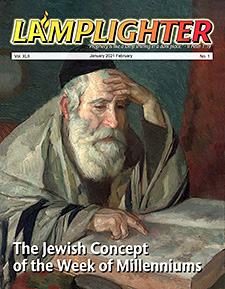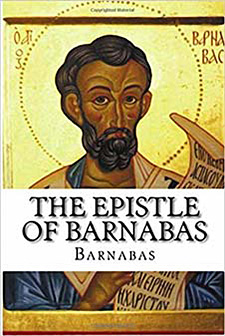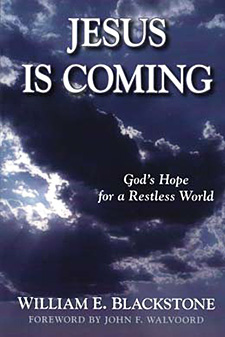The Prophecy of the Week of Millenniums
The Millennial Day Theory

The Scriptures contain an implied prophecy that strongly suggests that we are the terminal generation — the one that will experience the Rapture of the Church.
But before we take a look at it, let’s consider a fact that most Christians seem unaware of. Did you know that there is a prophecy in the Old Testament that clearly establishes the season of the Lord’s First Coming? It is found in the book of Daniel in chapter 9, beginning with verse 24. It is usually referred to as the “Prophecy of the 70 Weeks of Years.”

Daniel’s Designation for the Coming of the Messiah
The name of the prophecy comes from the fact that Daniel prophesies that certain events will occur among the Jewish people over a period of 490 years, or 70 weeks of years. He states very clearly that the Messiah will come before the end of 483 of these years. The question, then, that immediately emerges is, “What is the starting point for the countdown of these years?” Daniel says the countdown will begin with “the issuing of a decree to restore and rebuild Jerusalem” (Daniel 9:25).
After the Babylonian Empire was overthrown by the Medes and the Persians, three Persian kings issued edicts regarding the return of the Jews to their homeland. The first came in 538 BC, when Cyrus authorized Zerubbabel to rebuild the Temple in Jerusalem (Ezra 1:1-3). The second, issued by Artaxerxes in 457 BC, gave Ezra permission to reinstitute the Temple services, appoint judges and teach the Law (Ezra 7: 11-26). In 445 BC, Artaxerxes issued a decree for Nehemiah to rebuild the city of Jerusalem and its walls (Nehemiah 2:1-8).
On the surface, the third decree, the one issued to Nehemiah, seems to be the most obvious candidate for the starting date of the prophecy, for it is the only one that specifically relates to the rebuilding of the city. For that reason, most commentators have selected it as the beginning of the 70 weeks of years.
Using 445 BC as the starting point, experts on biblical chronology have concluded that the terminal point of the 483 years would be 27 AD at the earliest and 33 AD at the latest. The differences depend on whether you calculate using solar years or 360 day lunar years.
The point, of course, is that Jesus was born around 4 to 6 BC, and thus His arrival fits the prophecy since His birth occurred before the latest possible terminal point of the prophecy. And this fact presents a major problem to the Jews since they deny Jesus was the Messiah. If He was not, then how can they explain that the Messiah was not born within Daniel’s time period? After all, they recognize Daniel as a legitimate prophet of God.
The major point I want to make is that Daniel’s prophecy clearly revealed the season of the Lord’s First Coming. And, in like manner there are prophecies in both the Old and New Testaments that reveal the season of the Lord’s Second Coming — not the date, but the general season. And it is my contention that those prophecies point to our day and time, and thus we are the terminal generation.
An Implied Prophecy
One of the most important of those prophecies is one that is implied in the Genesis account of Creation, as found in Genesis chapter 2:
1) Thus the heavens and the earth were completed, and all their hosts.
2) By the seventh day, God completed His work which He had done, and He rested on the seventh day from all His work…
The Creation account, which consists of six days of labor followed by one day of rest is God’s template for time that is repeated over and over throughout the Scriptures. Consider the evidence below:
1) The Week of Days — Six days of labor followed by a Sabbath of rest.
2) The Week of Weeks — Seven weeks or forty-nine days between Passover and the Feast of Pentecost, concluding with a Sabbath day of rest.
3) The Week of Months — The seven months containing the seven feasts of Israel, beginning with Passover in the Spring and concluding with the Feast of Tabernacles in the Fall, which is a celebration of rest from the agricultural labors of the year.
4) The Week of Years — Seven years followed by a Sabbath year, when the land is allowed to rest from cultivation.
5) The Week of Weeks of Years — Forty-nine years leading up to the celebration in the 50th year of the Jubilee, and that year is to be a year of rest.
6) The Week of Millenniums — The idea that 6,000 years of human labor and strife will be followed by 1,000 years of rest during the Millennial Reign of the Messiah.
The last example of the week template that is mentioned above is the theme of this article. It is a concept that some Jews and Christians have agreed upon for the past two thousand years.

A Possible Pre-Jewish Example
In fact, there is evidence that the concept pre-dates the founding of the Jewish people with the call of Abraham. References to the 7,000 year theory can be found in writings attributed to Enoch who lived in the seventh generation from Adam and was Noah’s grandfather. Portions of at least ten quotes from the Book of Enoch were found in the Dead Sea Scrolls.
These writing are not canonical, but there is a quotation from them in the New Testament book of Jude (verses 14-15). It describes the Second Coming of the Messiah, pointing out that according to Enoch, the Messiah will one day come in judgment to pour out the wrath of God on “ungodly sinners.”
We know from non-biblical sources that the Second Book of Enoch stated that there would be 7000 years of history and that the beginning of the 8,000th year would mark the start of the Eternal State (2 Enoch 33:1).1
Whether these writings date from the time of Enoch or were written later by someone using his name, they indicate that the idea of 7,000 years of human history on this earth is a very old tradition.

Jewish Examples
The oldest existing Jewish reference to the Week of Millenniums is probably the one found in the Talmud which references a statement attributed to the prophetic school established by the prophet Elijah:
Six thousand years is the duration of the world. Two thousand of the six thousand years are characterized by chaos; two thousand years are characterized by Torah, from the era of the Patriarchs until the end of the mishnaic period; and two thousand years are the period of the coming of the Messiah (Sanhedrin 97a).
This concept is echoed in a 10th Century AD midrash called Tanna D’vei Eliyahu. (A midrash is commentary on part of the Hebrew scriptures.) It reads as follows:2 The world is to exist 6,000 years. In the first 2,000, there was desolation (no Torah, from Adam to Abraham), 2,000 years the Torah flourished, and the next 2,000 years is the Messianic era (He should have come at the beginning of the last 2,000 years; the delay is due to our sins).
Of course, the Messiah did come at the beginning of the last 2,000 years, but He was not recognized by the Jewish people.

This concept of 6,000 years of human toil and conflict followed by 1,000 years of rest is still alive among Jewish rabbis and is being taught by them. Take, for example, Rabbi Baruch S. Davidson, of Brooklyn, NY who is a writer for Chabad, an Orthodox Jewish Hasidic movement. When asked about the 7,000 year theory, he replied:3
The Talmud tells us that this world, as we know it, will last for six thousand years, with the seventh millennium ushering in the cosmic Sabbath, the Messianic Era. Six days a week we work, and on the Sabbath we rest and enjoy the fruits of our labor; the same is true with millenniums.
The widespread acceptance of the 7,000 year concept among Jewish sages today is illustrated by the fact that the idea is accepted “across the Ashkenazi-Sephardi divide, the Hasidim- Misnagdim divide, and across the rational Talmud and mystical Kabbalah perspectives.”4

Early Christian Writings
The Jewish Millennial Day Theory was picked up by the earliest fathers of the Christian faith and espoused by them. For example, Justin Martyr (100-165 AD), in his Dialogue with Trypho, asserted his belief that the earth will last for 6,000 years followed by a Sabbath of rest lasting 1,000 years.5
But even earlier than this, the concept was expressed in detail in The Epistle of Barnabas, the complete text of which is preserved in the 4th-century Codex Sinaiticus, where it appears immediately after the New Testament and before the Shepherd of Hermas. Scholars estimate it was written between 70 and 132 AD. The author describes the Millennial Day Theory in these words:6
“God made in six days the works of His hands, and made an end on the seventh day, and rested on it, and sanctified it” (Gen. 2:2). Attend, my children, to the meaning of this expression, “He finished in six days.” This implies that the Lord will finish all things in 6,000 years, for a day is with Him a thousand years… Therefore, my children, in six days, that is, in 6,000 years, all things will be finished. “And He rested on the seventh day.” This means: when His Son shall come, and shall abolish the time of the Lawless One, and shall judge the ungodly, and shall change the sun and the moon, and the stars, then shall He truly rest on the 7th day.” (Epistle of Barnabas, Chapter 15).
Late in the 2nd Century, Irenaeus (130-202 AD), the Bishop of Lyons, France, wrote: “For in as many days as this world was made, in so many thousand years shall it be concluded.” He then added that after the Antichrist has devastated the world, the Lord will return and provide the world rest on “the hallowed seventh day.”7
One of the most influential theologians of the 3rd Century, Hyppolytus of Rome (c. 170-235AD) asserted that “6,000 years must needs be accomplished in order that the Sabbath may come, the rest, the holy day on which God rested from all His works.”8
The widespread belief in the Millennial Day Theory among early Christians is attested to by Edward Gibbon in his history of the Roman Empire. He wrote:9
The ancient and popular doctrine of the Millennium was intimately connected with the second coming of Christ. As the works of the creation had been finished in six days, their duration in their present state, according to a tradition which was attributed to the prophet Elijah, was fixed to six thousand years. By the same analogy it was inferred that this long period of labor and contention, which was now almost elapsed, would be succeeded by a joyful Sabbath of a thousand years; and that Christ, with the triumphant band of the saints and the elect who had escaped death, or who had been miraculously revived, would reign upon earth till the time appointed for the last and general resurrection.
But despite this early popularity of the concept, it fell out of acceptance after 400 AD when the Roman Catholic Church, under the influence of the spiritualizing interpretations of Origen and Augustine, adopted the Amillennial viewpoint which argued that Jesus was never going to return to reign over this earth for a thousand years.
Modern Christianity
The Millennial Day Theory experienced a renaissance following the Reformation as people began to obtain copies of the Bible in their own languages. The Premillennial viewpoint of end-time events was revived and with it, the idea that 6,000 years of history would be followed by the 1,000 year reign of Jesus.

The concept was strongly endorsed in the first best-selling Bible prophecy book in history — Jesus Is Coming by W. E. Blackstone, first published in 1898. He pointed out that the concept was first developed by the Jewish sages before the time of Christ and is frequently mentioned in the Talmud. He called it “the Sabbath of God’s weeks.”10
Many modern day Bible prophecy teachers have also endorsed the theory. For example, in 2012, Dr. Jack Van Impe (1931-2020), one of the foremost proclaimers of Bible prophecy in the 20th Century, gave his support to the concept in an article printed in his newsletter.11 He endorsed it again in 2016, and concluded: “We are on the threshold of the final day!… One thing is certain: only a few minutes remain before midnight. Closing time is upon us. The Age of Grace is about to end, and believers are soon to rule and reign with the Lord Jesus Christ.”12
Distinguished Christian doctrinal expert, Mike Gendron, echoed the 7,000 year theory in an article he published in 2013 when he observed:13
The first 2,000 years of human history ended when the wrath of God was poured out on sin in the Flood. The second 2,000 years ended when the wrath of God was poured out on sin at the Cross. And the third 2,000 years will end with God pouring out His wrath on sin during the Tribulation.
Dating the 7,000 Year Theory
All of this brings us to a crucial question. If this Millennial Day Theory is biblical, then how near are we to the end of the 6,000 years that will inaugurate the Millennial reign of Jesus?
This is not an easy question to answer. The first question relates to the starting point of the 6,000 years. James Ussher (1581-1656), the Archbishop of Ireland in the early 17th Century and a profound scholar, calculated the beginning of the world to be 4004 BC, or exactly 4,000 years before the generally accepted date for the birth of Jesus in 4 BC.14 He based his finding on the biblical genealogies.

Many have challenged Ussher’s calculations. Others who accept them, have argued that the starting date for the 6,000 years countdown should be the date when Adam sinned. That date, of course, is not known, and it has been estimated to be anywhere from a few months after creation to as much as 110 years.15
The second question relates to the starting point for the countdown of the last 2,000 years — from the birth of Jesus or from His death? And in either case, what is the correct date? Some argue He was born in 4 BC; others in 6 BC. The generally accepted date for His crucifixion is 30 AD, but I am personally convinced it was 31 AD.16
Counting 2,000 years from 31 AD places His return around the year 2031. In my research, I found nearly all writers speculating anywhere from 2026 to 2033.
Another problem with all these calculations is whether you use normal years according to the solar calendar or lunar years of 360 days. And this is further complicated by the fact that the Jews used a lunar/solar calendar!
So, as you can see, it is not possible to precisely calculate either the beginning or the ending of the 6,000 years from creation. But by any calculations, the conclusion has to be that we are near the end.
Another Crucial Question
However, there is a question that immediately emerges from my conclusion. If we are near the end of the 6,000 years of human history, why is this the year of 5781 on the Jewish calendar? In other words, if we are so near the end of 6,000 years, why does the Jewish calendar say we are 219 years away from that date?
There is really a very simple answer to this question. Just as the Western Gregorian calendar is off by four to six years, the Jewish calendar contains an even greater error of over 200 years.
The calculation of the years of the Jewish calendar, according to the Talmud, was done in the 2nd Century AD by Rabbi Yose ben Halafta. His rabbinic chronology is called the Seder Olam Rabbah.17 It is almost universally agreed that the calendar is off by at least 200 years due to the fact that Rabbi Yose guessed wrong as to the length of the inter-testamental period for which there are no biblical records. This period is referred to by secular historians as “the Persian period.” The rabbinical chronology says it lasted 52 years. The accepted chronology of historical experts says it lasted 207 years, amounting to a difference of 155 years.
A remarkable book published in 1997 examines this problem in detail and proves beyond a shadow of doubt that the Jewish chronology is seriously flawed. It is titled Jewish History in Conflict.18 The author is a New York attorney and Orthodox Jew by the name of Mitchell First. All the errors he points out in the Jewish calendar amount to a total of over 200 years.
With such overwhelming evidence of major errors in the Jewish calendar, why don’t the Jews correct their calendar? The force of tradition is undoubtedly one of the main reasons. Another is what is called in Jewish circles “the doctrine of faith in the pronouncements of the Sages.” This doctrine requires that the Jewish Sages be given the benefit of the doubt.19
There is a third reason for Jewish reluctance, one that most rabbis and scholars are reluctant to admit. Mitchell First denies that it is of any significance, but he quotes three Jewish scholars who bluntly state that they are convinced this reason is the most important.20 It is the idea that the Jewish Sages purposely stated an incorrect chronology of Daniel 9 in order to prevent people from using the passage to accurately predict the time when the Messiah would come.
The bottom line is that instead of this being the Jewish year of 5781, it should, instead, be in the neighborhood of 5991 or later.

Other Substantiating Prophecies
There are two prophecies I would like to mention in closing, one from the Old Testament and the other from the New, both of which substantiate the Millennial Day Theory and indicate that we are definitely living in the season of the Lord’s return.
The first was spoken by Jesus in the Olivet Discourse that He delivered to His disciples during the last week of His life. In Matthew 24:32-34 Jesus stated in the “Parable of the Fig Tree” that when the fig tree blossoms again, the generation that witnesses that event will be the one that will be living when the Lord returns.
Throughout the Scriptures, the fig tree is often used as a symbol of Israel. In fact, an indication of this occurred the day before Jesus spoke this parable. As He and His disciples were walking on the Mount of Olives, they came across a fig tree that was barren. Jesus pronounced a curse upon it, and it withered (Matthew 21: 18-19). This was a symbolic prophecy that because the Jewish people (represented by the fig tree) had rejected Jesus as their Messiah (and were therefore barren), their nation would cease to exist.
Then, the next day, Jesus reminded them of the tree and said when it blossoms again (when the nation is re-established), the Lord will return. That prophecy, like the prophecy of the Millennial Days, indicates we are living in the season of the Lord’s return.
The second prophecy that substantiates the Millennial Day Theory is found in Hosea 5:15 through 6:3. This passage says the Messiah will return to Heaven and remain there until the Jewish people acknowledge their guilt in rejecting Him and earnestly seek His face — something that will happen during a time of severe trouble for them (the Tribulation). The Messiah will be gone for “two days.” He will return on “the third day” and will raise up the Jewish people, refreshing them like a spring rain.
As God calculates time, it has been “two days” since Jesus ascended to Heaven, for to God, “one day is as a thousand years, and a thousand years as a day” (2 Peter 3:8 and Psalm 90:4).
Conclusion
No one can know the date of the Lord’s return, but the signs of the times and the prophecies like the ones considered in this article definitely indicate that we are the terminal generation, living in the season of the Lord’s return.
The crucial question is this one: Are you ready? If Jesus were to appear in the heavens today to take His Church out of this world before the Great Tribulation, would you be ready? Would you welcome Him with great rejoicing, like a calf released from a stall? (Malachi 4:2). Or, would you crawl into a hole in the ground and cry out for the mountains to fall on you? (Luke 23:30).
To be ready for the Lord’s return at any moment, all you must do is repent of your sins and receive Jesus as you Lord and Savior. You will be born again and receive the indwelling of the Holy Spirit who will seal you for redemption and serve as your spiritual guide and helper as you begin living your life for Christ. When you do this, you should seek out a Bible believing church that exalts Jesus as the only hope for the world. You need also to witness your faith in baptism and get involved in a Bible study group so that you can start growing in the Lord.
References
1) William F. Dankenbring, “Six Thousand Years and Beyond,” (www.triumphpro.com/6000-year-plan.htm), pages 11-12.
2) Jim Bramlett, “Christ’s Soon Return: The Overwhelming Evidence,” (http://choicesforliving.com/spirit/part3/christreturn.htm), page 4.
3) Dankenbring, pages 8-9.
4) Craig Crawford, “The 7th Day Prophecy: A 6,000 Year Climax,” (www.theprophecies.com/year-20xx-the-7th-day), page 11.
5) James Johnson, “The Prophets Foresee the End of the World After 6000 Years,” (http://allpowertothelamb.com/2010/01/the-prophets-foresee-the-end-of-the-world-after-6000- years), page 1.
6) Dexter B. Wakefield, “The 7,000 Years Doctrine,” (www.lcg.org/lcn/2012/September-October/7000-years-doctrine), page 2.
7) Bob Thiel, “Does God Have a 6,000 Year Plan?” (www.cogwriter.com/six_thousand_year_plan_6000.htm), pages 9-10).
8) Bob DeWaay, “Premillennialism and the Early Church Fathers, (http://cicministry.org/scholarly/sch008.him), page 5.
9) Wakefield, page 2.
10) William E. Blackstone, Jesus Is Coming (Grand Rapids, MI: Kregel Publications, 1989 updated edition), page 40.
11) Jack Van Impe, “The Return of Jesus is Imminent,” Jack Van Impe Ministries International Newsletter, July 1, 2012, pages 3-5.
12) Jack Van Impe, “The 6,000 Year Theory,” Jack Van Impe Ministries International Newsletter, September 19, 2016, pages 1-2.
13) Mike Gendron,
14) Wikipedia, “James Ussher,” https://en.wikipedia.org/wiki/James_Ussher.
15) Bodie Hodge, “When Did Adam and Eve Rebel?” https://answersingenesis.org/adam-andeve/when-did-adam-and-eve-rebel.
16) David R. Reagan, “A Bible Prophecy Problem Concerning the Resurrection,” Lamplighter magazine, March-April 2011, pages 8-9.
17) The Talmud, Yevamot 82b and Niddah 46b.
18) Mitchell First, Jewish History in Conflict: A Study of the Major Discrepancy Between Rabbinic and Conventional Chronology (Northvale, NJ: Jason Aronson, Inc., 1997) 233 pages.
19) Brad Aaronson, “Fixing the History Books: Dr. Chaim S. Heifetz’s Revision of Persian History,” Jewish Action, Summer 1991, pp. 66-70 and Fall 1991, pp. 9-13.
20) The three Jewish scholars who have argued that the misinterpretation of Daniel 9 was done purposely to obscure the chronology of the Messiah’s coming are Simon Schwab (1962), Samuel Kedar (1984), and Samuel Hakohen (1988). See First’s book, pp. 66, 75, and 78.




